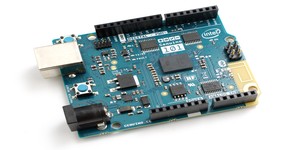Intel has officially unveiled the Galileo Gen 2, a redesign of the original Galileo development board that looks to address issues with its predecessor.
The original Intel Galileo was launched by the company in October 2013 as its first hobbyist-themed developer board. Developed in conjunction with the Arduino project and boasting its official certification, the Galileo was the first outing for Intel's low-power Quark chip. Although promising full Arduino compatibility with embedded Linux and the familiarity of the Pentium x86 instruction set architecture, the board launched with a number of issues that made it a less than popular choice with hobbyists.
Those who found the 400MHz Quark chip too slow for their projects will be disappointed to hear that the Gen 2 makes no changes in this regard: it's still powered by the same 32-bit single-core chip as its predecessor. Improvements have been made to the way the general-purpose input-output (GPIO) pins operate, however, boosting their performance considerably and improving their compatibility with Arduino shields and accessories. The board's pulse-width modulation (PWM) resolution has been increased to 12 bits, while the esoteric RS232-level serial connection provided by a 3.5mm jack has been replaced with the more standard six-pin TTL serial connectivity found on rival boards.
Additional improvements include power supply circuitry that can accept inputs between 7V and 15V, replacing the fixed-voltage input of the original. This should make the Galileo better suited to embedded projects that use battery power, although its high power draw compared to a microcontroller-based Arduino may still put many off using it in such a manner.
The new board will replace the original model, and is expected to sell at the same price point of £55 in the UK.
The original Intel Galileo was launched by the company in October 2013 as its first hobbyist-themed developer board. Developed in conjunction with the Arduino project and boasting its official certification, the Galileo was the first outing for Intel's low-power Quark chip. Although promising full Arduino compatibility with embedded Linux and the familiarity of the Pentium x86 instruction set architecture, the board launched with a number of issues that made it a less than popular choice with hobbyists.
Those who found the 400MHz Quark chip too slow for their projects will be disappointed to hear that the Gen 2 makes no changes in this regard: it's still powered by the same 32-bit single-core chip as its predecessor. Improvements have been made to the way the general-purpose input-output (GPIO) pins operate, however, boosting their performance considerably and improving their compatibility with Arduino shields and accessories. The board's pulse-width modulation (PWM) resolution has been increased to 12 bits, while the esoteric RS232-level serial connection provided by a 3.5mm jack has been replaced with the more standard six-pin TTL serial connectivity found on rival boards.
Additional improvements include power supply circuitry that can accept inputs between 7V and 15V, replacing the fixed-voltage input of the original. This should make the Galileo better suited to embedded projects that use battery power, although its high power draw compared to a microcontroller-based Arduino may still put many off using it in such a manner.
The new board will replace the original model, and is expected to sell at the same price point of £55 in the UK.

MSI MPG Velox 100R Chassis Review
October 14 2021 | 15:04









Want to comment? Please log in.